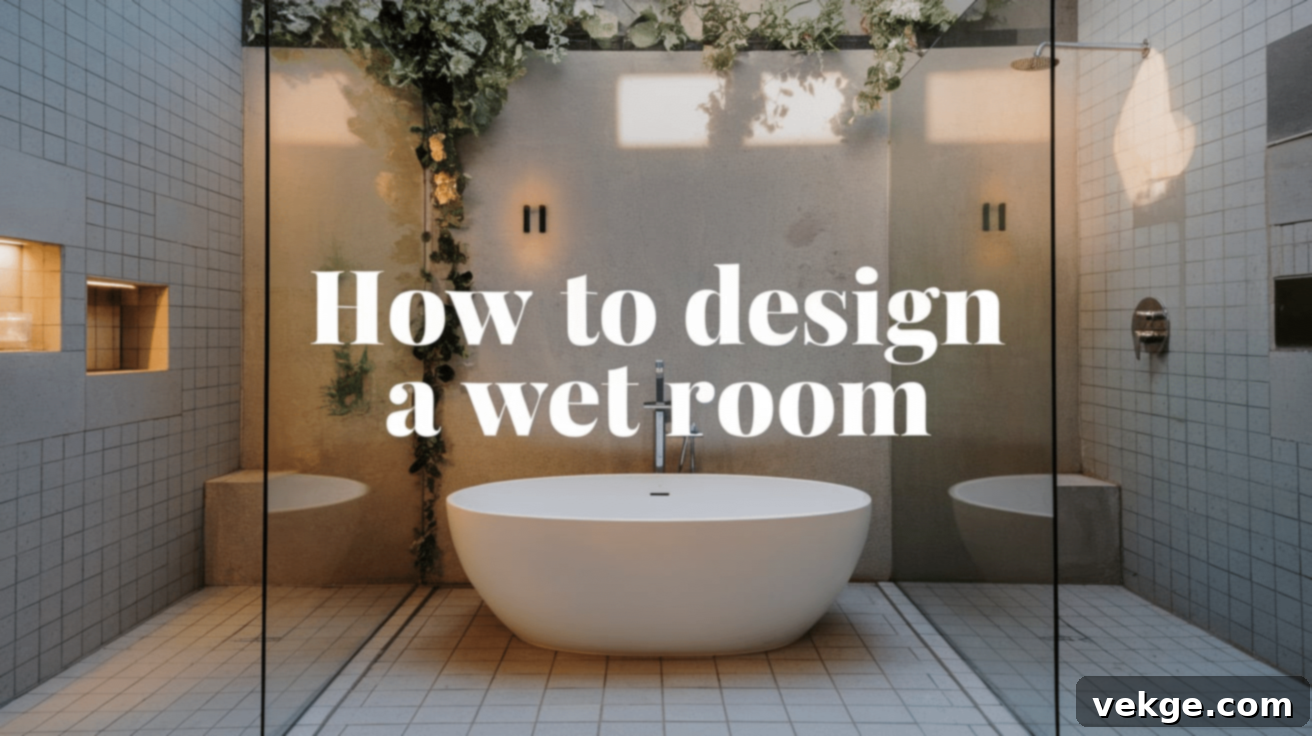Transform Your Bathroom: The Ultimate Guide to Designing a Wet Room with Both a Tub and Shower
Imagine stepping into a bathroom that epitomizes modern luxury and functionality – a seamless, open space where the indulgent comfort of a deep soaking tub gracefully coexists with the invigorating convenience of a contemporary shower. This vision is not just a dream but an achievable reality with a thoughtfully designed wet room. Far beyond a fleeting trend, a wet room integrating both a tub and shower offers a sophisticated, space-saving, and highly accessible solution that can significantly enhance your home’s aesthetic appeal and market value.
The prospect of designing such a versatile and integrated space might initially seem complex. However, with clear, step-by-step guidance and a solid understanding of the essential elements, creating your ideal wet room is an incredibly rewarding home improvement journey. This comprehensive guide will equip you with all the knowledge required, from the foundational planning stages to the crucial final touches that bring your vision to life.
We will explore how to select the optimal layout for your specific bathroom, choose the perfect fixtures and finishes, ensure flawless and long-lasting waterproofing, and discover innovative design concepts that will inspire and elevate your space. By the time you conclude this guide, you will possess the confidence and expertise to craft a stunning wet room that perfectly aligns with your personal style, seamlessly integrates into your daily routine, and caters to all your diverse bathing preferences.
What Exactly Defines a Wet Room?
At its core, a wet room is a bathroom designed without the traditional confines of a separate shower enclosure or curtain. Instead, the shower area is completely open, or at least minimally separated, with the entire floor (or a significant portion) fully waterproofed and subtly sloped towards a flush-level drain. This design philosophy creates an uninterrupted, minimalist, and highly functional environment that evokes a profound sense of openness and spaciousness, even within more compact bathrooms.
The true genius of a wet room is unveiled when you integrate a bathtub alongside the shower. This combination unlocks an extraordinary level of versatility, allowing you to fluidly transition between a quick, refreshing shower and a leisurely, immersive bath within the same harmonized space. Wet rooms are highly praised for their clean lines, uncluttered appearance, and the remarkable illusion of expansive space they create, making them a premier choice for contemporary homes and those seeking enhanced accessibility in their bathing areas.
Beyond their striking aesthetics, wet rooms offer distinct practical advantages. Their continuous, unbroken surfaces are typically easier to clean, as there are fewer corners and crevices where dirt and grime can accumulate. The absence of steps or raised shower trays also significantly improves accessibility, making wet rooms an ideal solution for individuals with mobility challenges. Adding a tub to this versatile setup simply magnifies the luxury and practicality, providing a perfect bathing solution for every member of the household.
Crafting Your Dream Wet Room: Design and Build Essentials
Embarking on a wet room project is a significant investment that demands meticulous planning and precise execution. Adhering to these fundamental steps will ensure your project culminates in a beautiful, highly functional, and enduring bathing sanctuary.
1. Strategic Space Assessment: Choosing the Right Location for Your Wet Room
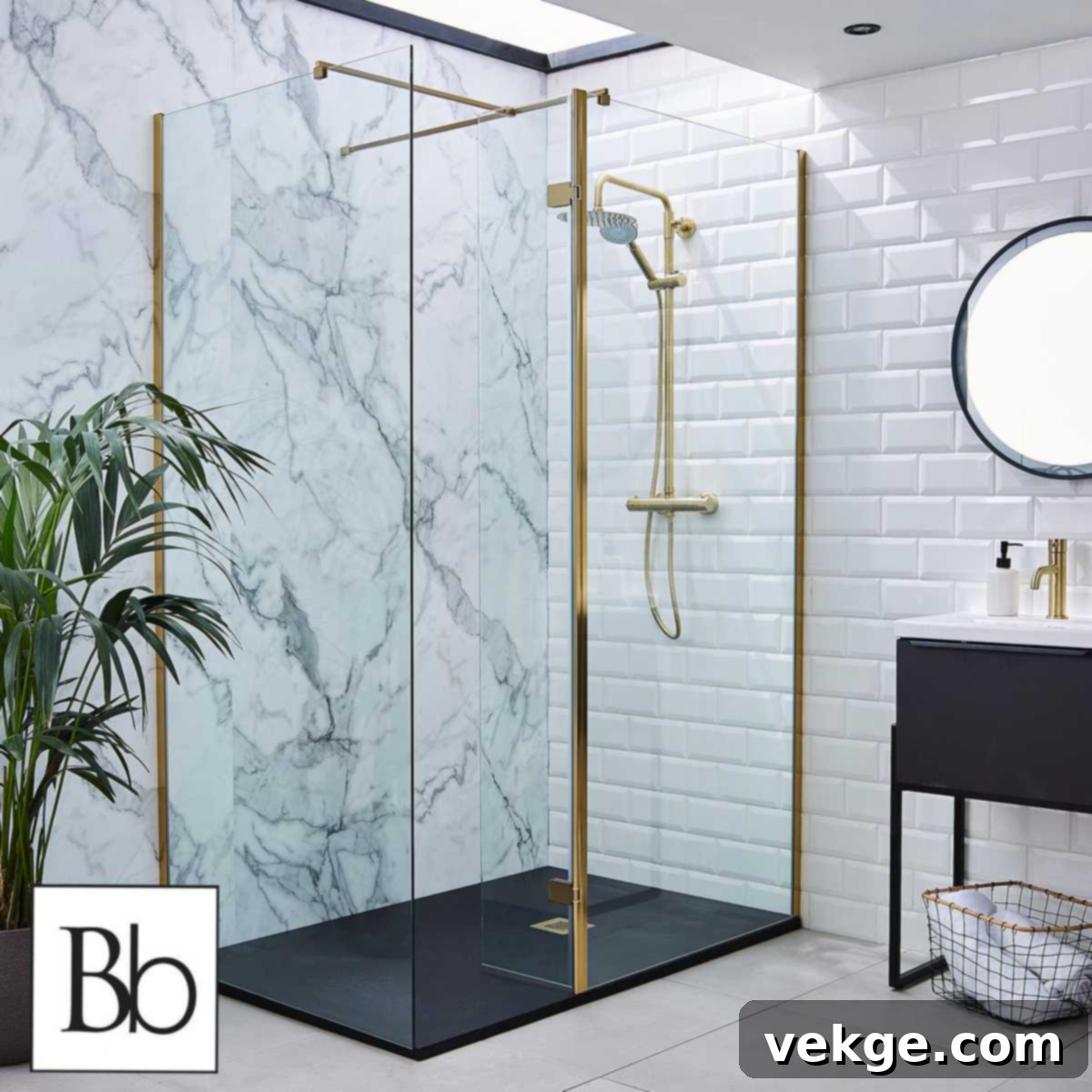
Image Credit: Wet Room by Bella Bathrooms
The initial and most crucial step in your wet room creation is a thorough assessment of your existing bathroom or the space designated for conversion. While wet rooms are renowned for their adaptability, the dimensions and configuration of the room will profoundly influence your design choices, particularly the feasibility of comfortably incorporating both a tub and a shower.
Bathroom Size, Layout, and Structural Considerations
For bathrooms with limited square footage, strategic planning is essential. You might consider a clever corner setup where the tub and shower share a more intimate footprint. This often involves a meticulously designed walk-in shower area positioned directly adjacent to a compact built-in or freestanding tub. Conversely, larger bathrooms afford the luxury of expansive, open layouts, enabling a grander, spa-like experience. In such cases, a striking freestanding tub can serve as a magnificent central focal point, with the shower area seamlessly integrated nearby, perhaps artfully concealed behind a partial wall or a substantial glass panel.
Privacy and Optimal Ventilation
Given the inherently open nature of wet rooms, privacy demands careful consideration. While an entirely open design is a popular aesthetic, the judicious application of glass partitions, elegant decorative screens, or even a tastefully designed half-wall can provide essential visual separation without compromising the desired airy ambiance. Furthermore, robust ventilation is absolutely critical. A powerful, high-capacity extractor fan is an indispensable component in any wet room, vital for effectively managing humidity levels, actively preventing mold and mildew growth, and ensuring the space dries rapidly after each use. This protects your significant investment and maintains superior indoor air quality.
Finally, a thorough assessment of your floor’s structural integrity is paramount. Wet rooms, especially those incorporating heavy bathtubs and extensive tiling, introduce considerable weight. Consulting with a qualified structural engineer or an experienced builder is highly recommended to confirm that your existing floor structure can safely support the proposed design without any issues.
2. Waterproofing: The Undeniable Foundation of Your Wet Room
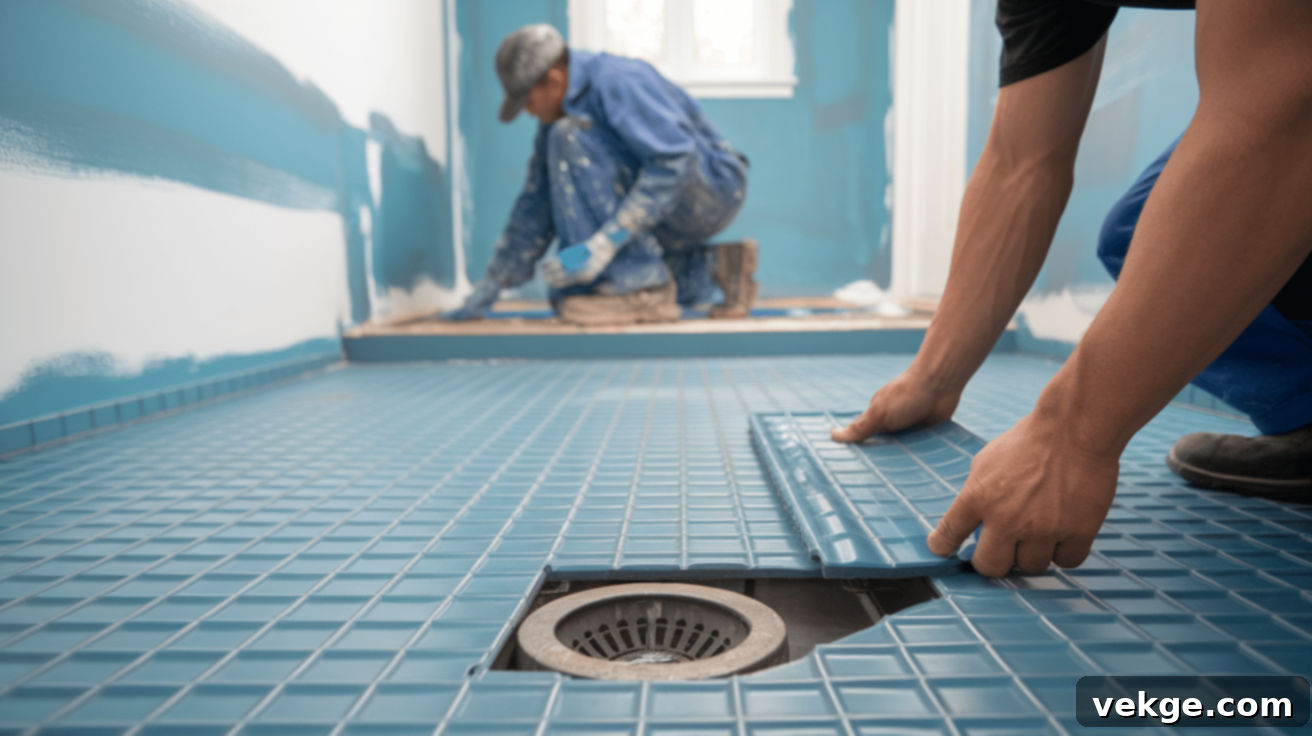
Without a doubt, proper and comprehensive waterproofing – often referred to as ‘tanking’ – stands as the single most critical element in constructing a successful, durable, and trouble-free wet room. This process extends far beyond merely using water-resistant materials; it involves creating an absolutely impervious barrier that will protect your home from any potential water damage for decades to come. Any compromise on this crucial step will inevitably lead to expensive and disruptive problems in the future.
Implementing a Robust “Tanking” System
A genuinely effective wet room mandates a comprehensive ‘tanking’ system. This involves meticulously applying a continuous waterproof membrane to the floor and all walls within the wet zone, extending well beyond the immediate shower and tub areas. This membrane, typically a liquid-applied paint-on solution or a flexible sheet material, forms an unbroken, impenetrable seal. Meticulous attention must be given to all seams, internal and external corners, and especially any penetrations (such as pipework), where specialized waterproof tape or sealant is used to eliminate any potential weak points in the barrier.
Optimal Waterproof Walls and Flooring Materials
Once the tanking system is flawlessly installed and cured, you can proceed with selecting your finish materials. For walls, ceramic, porcelain, or natural stone tiles are immensely popular choices due to their exceptional durability, inherent water resistance, and vast aesthetic versatility. Opting for large format tiles can significantly reduce the number of grout lines, making ongoing cleaning much simpler. As an alternative, seamless acrylic or composite panels offer a sleek, contemporary look with the added benefit of being entirely grout-free. For flooring, highly anti-slip tiles are an absolute imperative for safety. Excellent choices include textured porcelain, certain natural stones, or specialist non-slip vinyl flooring. Crucially, ensure that all grout and adhesives utilized are specifically formulated for wet environments, providing superior moisture resistance and flexibility.
Precision Floor Sloping and Advanced Drainage Solutions
The floor of your wet room must be meticulously sloped towards the drain to ensure rapid and efficient water runoff, thereby preventing any standing water or pooling. A typical and effective slope ranges from 1:80 to 1:100 (indicating a 1 cm drop for every 80-100 cm of distance). This precise gradient is achieved either by installing a pre-formed shower tray former or by expertly building up the floor screed. The choice of drain is also pivotal: a linear drain (or channel drain) gracefully running along one edge or wall often creates a sleek, minimalist aesthetic, while a central point drain offers a more traditional approach. Both types must be easily accessible for routine cleaning and robustly designed to efficiently handle the water flow generated by both the shower and the tub.
3. Optimizing Your Layout: Balancing Functionality with Flow
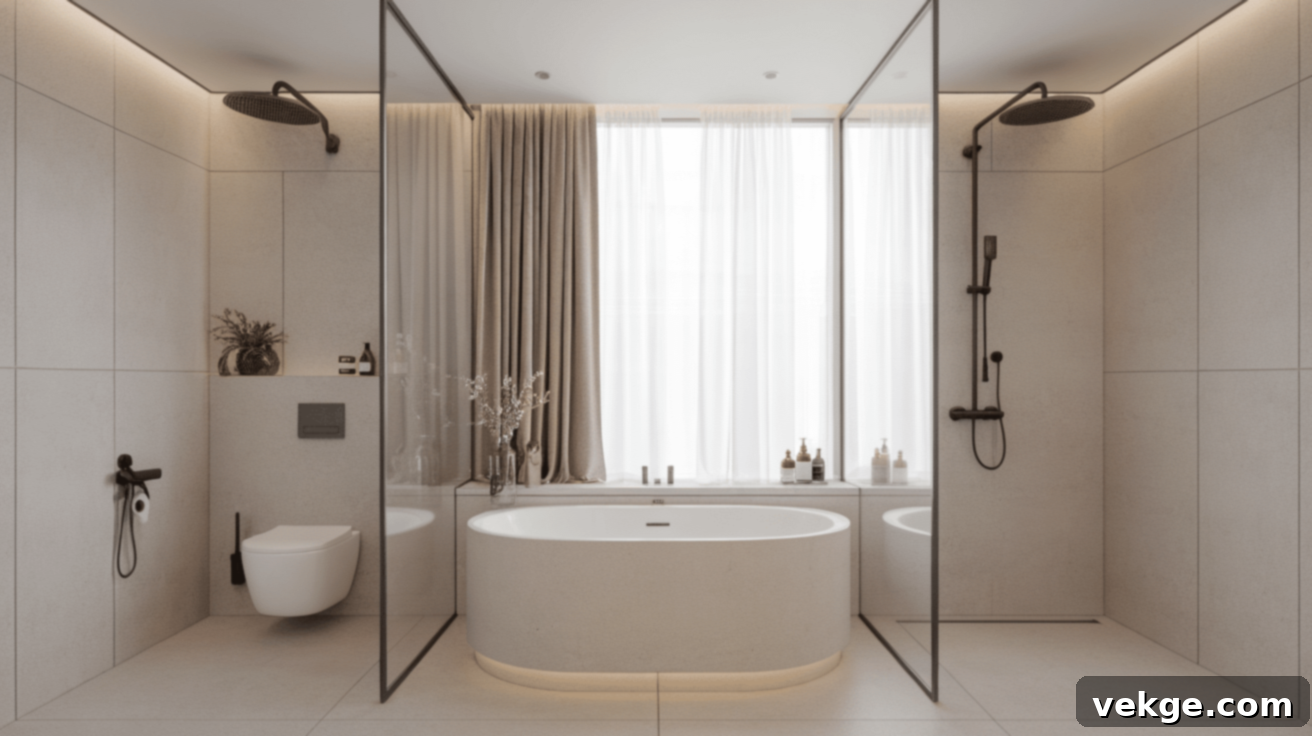
The layout is where your wet room truly begins to take distinctive shape, defining both its practicality and its visual appeal. With the luxury of incorporating both a bathtub and a shower, you are presented with a wealth of design possibilities. The overarching objective is to orchestrate a harmonious space that is not only visually stunning but also exceptionally practical for your daily routines and specific needs.
The Bathtub as a Central Statement Piece
In a generously proportioned wet room, strategically placing a magnificent freestanding bathtub as a central or highly prominent feature can create a breathtaking focal point. The adjacent shower area can then gracefully wrap around it or be positioned nearby, perhaps subtly delineated by a tasteful glass screen for effective splash protection. This layout inherently exudes an aura of unparalleled luxury and fosters an unencumbered sense of spaciousness, making it an ideal choice for a luxurious master bathroom suite.
Efficient Corner Configurations
For bathrooms with more modest dimensions, a corner layout presents an ingenious space-saving solution. By positioning both the tub and shower compactly within one corner, you can maximize the efficient utilization of the room’s footprint. An L-shaped or elegantly curved glass partition can effectively delineate the showering zone while seamlessly maintaining an open visual connection to the tub and the rest of the room. This design strategy effectively minimizes the spread of water splashes beyond the designated wet zone.
Streamlined Side-by-Side or Linear Arrangements
If your bathroom exhibits a long, narrow configuration, arranging the bathtub and shower side-by-side along a single wall can prove to be an exceptionally efficient layout. This linear configuration simplifies plumbing installation and creates a clear, unobstructed pathway through the room. It can be particularly effective with a walk-in shower positioned at one end and a built-in or freestanding tub immediately adjacent, unified by a continuous and elegant floor treatment.
Always consider the strategic proximity of other essential bathroom fixtures, such as the toilet and sink. Ensure that ample clear space surrounds each element, guaranteeing comfortable usage, easy maintenance, and unimpeded movement throughout the room. Sketching various layout options or utilizing sophisticated 3D rendering software can be invaluable tools for visualizing and determining the optimal fit for your specific space and preferences.
4. Choosing the Right Bathtub to Perfectly Complement Your Wet Room

The bathtub serves as a pivotal element within your wet room, offering a dedicated sanctuary for ultimate relaxation and rejuvenation. Your selection will profoundly influence both the room’s overarching aesthetic and your personal bathing experience.
The Timeless Elegance of a Freestanding Tub
Freestanding tubs are universally synonymous with luxury and make an unequivocal design statement. Available in an extensive array of shapes – from classic clawfoot designs to sleek, ultra-contemporary oval or rectangular forms – and crafted from diverse materials such as acrylic, traditional cast iron, sophisticated stone resin, or even opulent copper, they possess the transformative power to become the artistic centerpiece of your wet room. While they typically demand more generous floor space, their sculptural presence is unparalleled, particularly when strategically positioned centrally or beneath a captivating window.
The Practicality and Integration of a Built-in Tub
For bathrooms where spatial efficiency is a premium concern or a more seamlessly integrated aesthetic is desired, a built-in tub presents an excellent choice. These tubs are typically expertly installed against a wall or nestled within an alcove, often impeccably clad with the very same tiles used throughout the rest of the wet room for a cohesive and unified appearance. They can also offer practical advantages, such as providing a convenient ledge for essential toiletries or contributing to a cleaner, less cluttered visual profile, especially when intelligently combined with a shower-over-bath setup if that is your preferred functionality.
Innovative Shower-Bath Combinations and Specialist Tubs
Several innovative designs ingeniously combine a tub and shower within one compact unit, often featuring an integrated shower screen or a wider, flatter base specifically engineered for safer and more comfortable showering. These designs are superb for smaller wet rooms where maximizing multifunctional utility is paramount. Also, consider exploring specialist tubs, such as luxurious whirlpool or invigorating air-jet baths, for an added dimension of spa-like indulgence, always ensuring that any integrated electrical components are safely rated (IP rated) for the humid wet room environment.
When making your bathtub selection, carefully consider its material (for properties like heat retention and ease of maintenance), its depth (for truly comfortable and immersive soaking), and its overall proportion within your chosen wet room layout. It is crucial to account for the substantial weight of a filled tub and its occupants, particularly if you are gravitating towards heavy materials like traditional cast iron.
5. Selecting the Ideal Shower Features for a Bespoke Spa-Like Experience
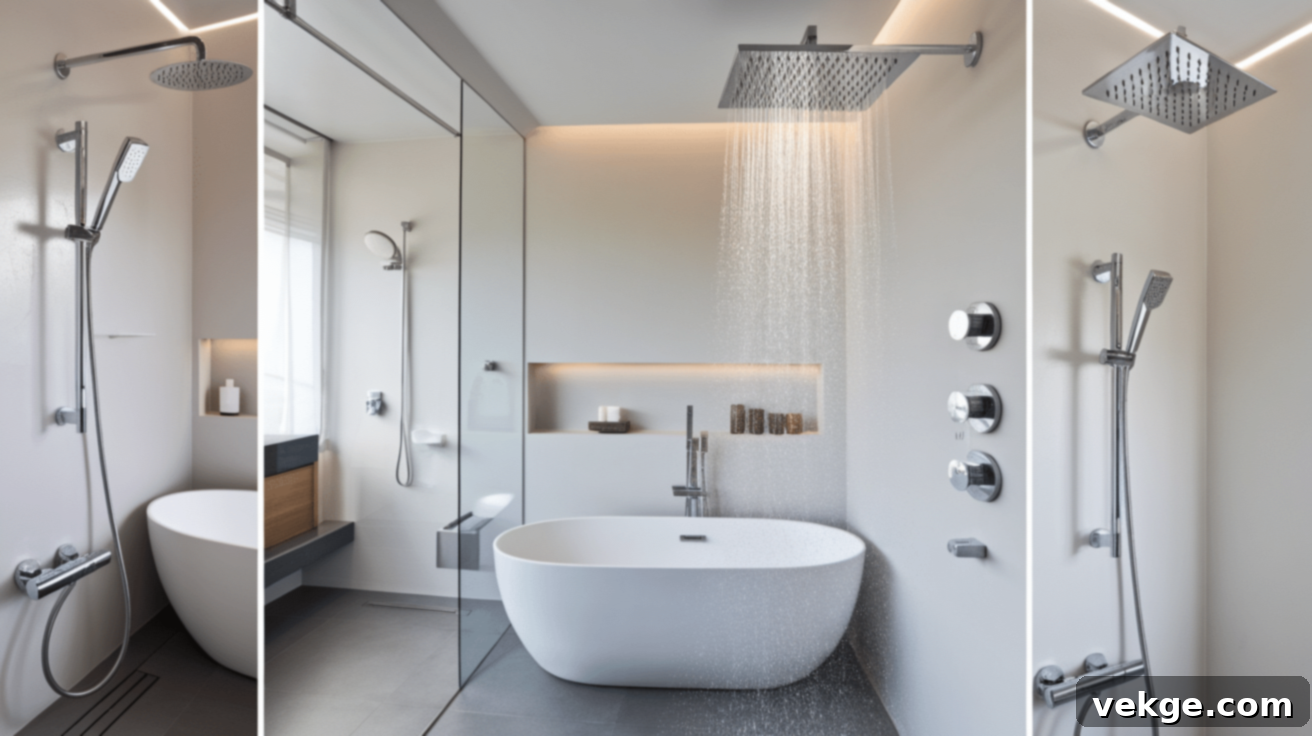
Your chosen shower system is as critically important as your bathtub, possessing the power to transform a mere functional necessity into an invigorating and indulgent daily ritual. The inherently open design of a wet room provides an unparalleled canvas for creative and luxurious shower installations.
Diverse and Luxurious Showerhead Options
Explore the extensive variety of showerhead types to pinpoint what best suits your preferences. A generously sized, ceiling-mounted rain showerhead delivers a truly luxurious, all-encompassing drenching experience. For enhanced flexibility and practicality, a handheld showerhead is indispensable, particularly if you have a freestanding tub (for effortless rinsing) or require assistance with children or pets. Wall-mounted showerheads are available in a myriad of styles and spray patterns. Consider combining several types for a truly versatile and personalized shower experience. For the ultimate spa sensation, strategically incorporate body jets mounted on the wall for a stimulating hydro-massage.
Advanced and Intuitive Shower Controls
Moving beyond simple mixer taps, contemporary wet rooms often feature advanced thermostatic shower valves, which precisely maintain a consistent water temperature, effectively preventing any sudden scalding or chilling. For cutting-edge convenience and unparalleled luxury, consider investing in a digital shower system. These innovative systems allow you to meticulously pre-set precise temperatures and flow rates, initiate the shower remotely, and even seamlessly integrate with smart home automation systems, all contributing to an utterly seamless and deeply personalized bathing experience.
Integrated Shower Comforts: Thoughtful Benches and Niches
To significantly enhance both comfort and convenience within your shower area, consider integrating a stylish built-in shower bench or seat. This provides a practical and comfortable spot for sitting, which is particularly useful for shaving, for those who prefer to sit, or for individuals with specific mobility needs. Similarly, expertly recessed niches, meticulously built into the shower wall, offer discreet and highly stylish storage for toiletries, effectively keeping the space elegantly clutter-free without the need for unsightly or intrusive caddies. Crucially, ensure that these niches are also thoroughly waterproofed and gently sloped to allow any water to drain effectively.
When selecting your shower fixtures, always prioritize superior quality and materials explicitly designed for rigorous wet environments. Finishes such as polished chrome, sophisticated brushed nickel, or sleek matte black can beautifully complement and enhance your overall wet room design aesthetic.
6. Utilizing Glass Partitions for Elegant Separation and Splash Control
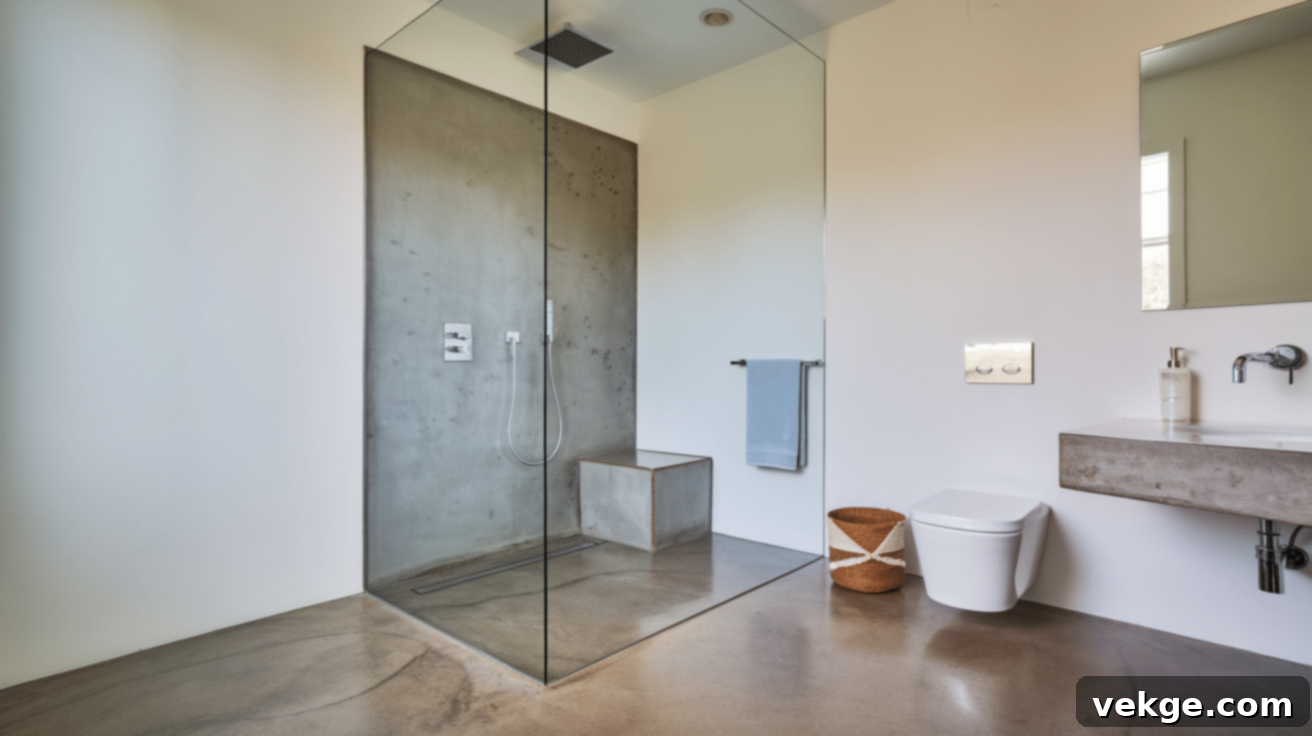
One of the defining characteristics of a truly contemporary wet room is the strategic and artful incorporation of glass. While the fundamental absence of traditional shower enclosures defines the essence of a wet room, glass partitions are invaluable for effectively containing splashes, gracefully delineating distinct zones, and preserving that highly coveted open and airy aesthetic.
Sleek Fixed Glass Screens and Panels
A simple, elegantly fixed glass screen or panel often represents the ideal solution. It establishes a subtle yet effective barrier between the shower area and the remainder of the bathroom (or the tub zone) without visually interrupting the spatial flow. These frameless or minimalist-framed panels maintain an unobstructed view, allowing natural and artificial light to permeate freely, thereby making the entire room feel significantly larger. They are particularly effective in intelligently directing water towards the floor drain while ensuring that towels, bath mats, and other bathroom elements remain comfortably dry.
Commanding Full-Height Glass Walls for Defined Zones
In more expansive wet rooms, a full-height glass wall can be employed to more distinctly separate the showering and bathing zones or to create an entire, transparent enclosure for the comprehensive wet area. This provides maximum splash containment while unequivocally retaining a luxurious, visually transparent feel. Available options include crystal-clear glass for ultimate openness, frosted or artfully fluted glass for enhanced privacy or a decorative flourish, and low-iron glass for unparalleled clarity and purity of vision.
It is imperative to ensure that any glass selected is safety glass (specifically tempered or laminated) and fully complies with all relevant local building codes and safety regulations. Professional installation is profoundly recommended to guarantee structural stability, precise alignment, and impeccable sealing. Routine cleaning with a squeegee after each shower can significantly prevent the accumulation of unsightly water spots and maintain the pristine, sparkling appearance of the glass.
7. Mastering the Art of Wet Room Lighting Design
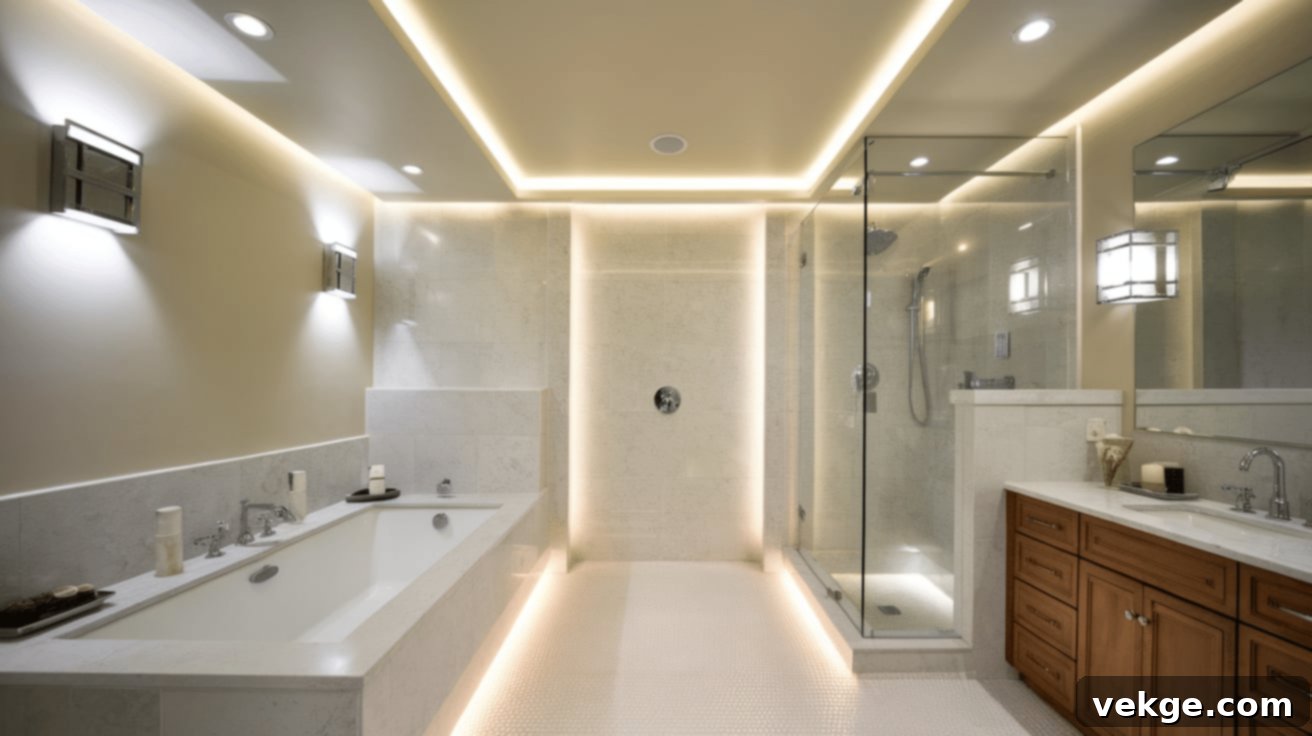
Lighting plays an absolutely pivotal role in defining the overall look, feel, and functionality of your wet room. A meticulously designed lighting scheme has the power to transform the space from merely practical to genuinely luxurious, inviting, and truly spa-like.
Functional and Discreet Recessed Lighting
Recessed downlights (commonly known as spotlights) are an undisputed staple in contemporary wet room design. Expertly installed flush with the ceiling, they provide unobtrusive, even, and consistent general illumination throughout the room. Crucially, all lighting fixtures installed within a wet room must possess the appropriate IP (Ingress Protection) rating, which specifically indicates their proven resistance to both water ingress and dust particles. Lights positioned directly above the shower or bathtub area will necessitate a higher IP rating (e.g., IP65) compared to those located further away from direct water exposure.
Ambient Wall Sconces and Sophisticated Accent Lighting
To cultivate a softer, more intimate, and truly spa-like ambiance, augment your overhead lighting with elegant wall sconces. Strategically placed near the mirror, above the vanity, or gracefully alongside the bathtub, these fixtures can introduce a warm, inviting glow and visually enhance the room’s design. Consider dimmable options to allow for adjustable brightness, perfectly suiting both invigorating morning routines and profoundly relaxing evening soaks. Integrated LED strip lighting, discreetly installed into recessed niches, beneath floating vanity units, or even around the base of the tub, can provide stunning accent illumination, adding profound depth, a modern edge, and an element of subtle drama.
Maximizing Natural Light Integration
Whenever architecturally feasible, prioritize and maximize the integration of natural light. Large, strategically placed windows or carefully chosen skylights can dramatically brighten a wet room, making it feel significantly more expansive and beautifully connected to the outside world. If privacy is a design concern, consider employing frosted glass, smart switchable glass, or thoughtfully positioned window treatments that effectively allow ample light to filter in while gracefully obscuring direct views. The presence of abundant natural light inherently reduces the dependency on artificial lighting during daylight hours and profoundly enhances the overall sense of well-being within the space.
8. Implementing Smart Storage Solutions for a Perfectly Clutter-Free Space
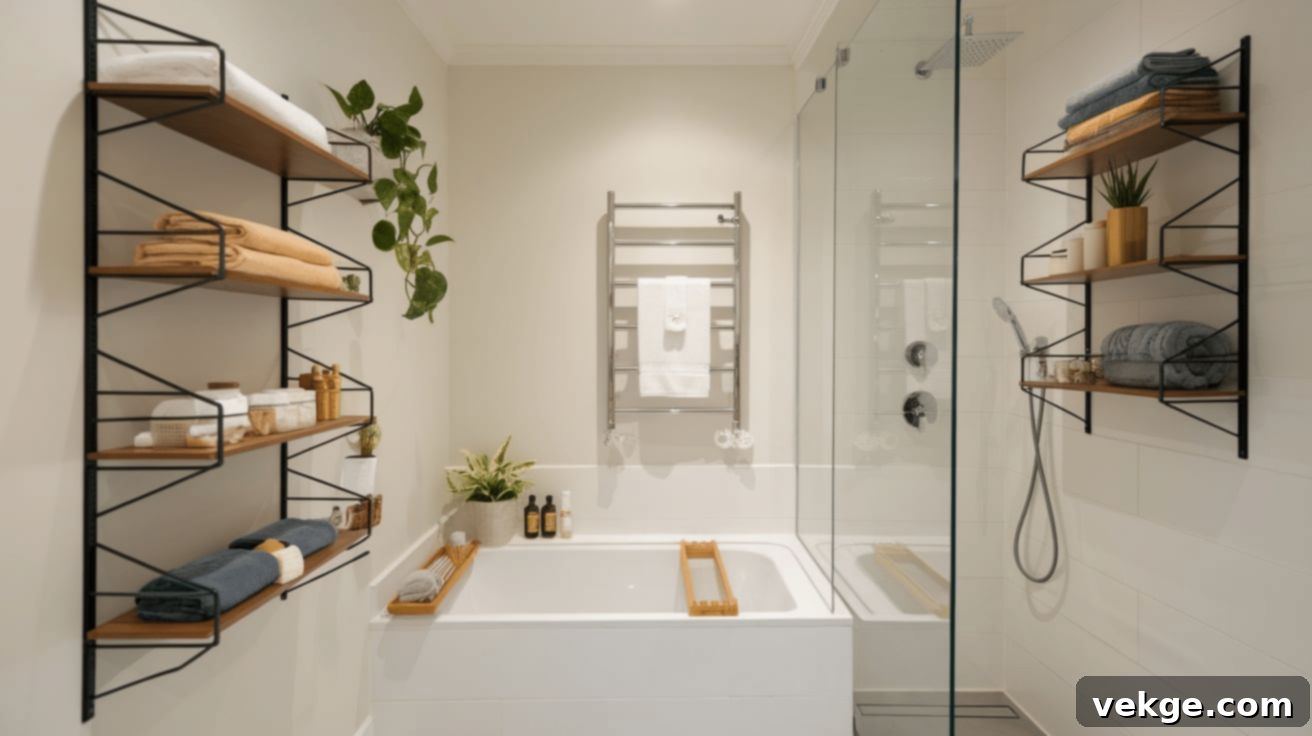
Maintaining a clean, minimalist, and ultimately clutter-free aesthetic is absolutely paramount to preserving the core appeal and serene ambiance of a wet room. Thoughtfully designed and strategically implemented storage solutions are therefore indispensable for keeping all toiletries, fresh towels, and cleaning supplies neatly organized, discreetly out of sight, and protected from moisture.
Recessed Niches and Stylish Wall-Mounted Shelving
As previously highlighted in the discussion of shower features, expertly built-in recessed niches are unequivocally ideal for keeping shower essentials perfectly at hand. Extend this intelligent concept to other areas of your wet room – a recessed cabinet elegantly positioned above the toilet or a discreet niche adjacent to the bathtub can provide invaluable, unobtrusive storage. Wall-mounted floating shelves or open shelving units, crafted from rigorously waterproof materials such as solid surface composites, genuine teak, or high-quality treated woods, offer both stylish storage and the crucial benefit of not occupying any precious floor space. Ensure that any open shelving is strategically located well outside the primary splash zone to keep stored items consistently dry.
Integrated Vanity Units and Clever Under-Tub Storage
A meticulously designed vanity unit, complete with ample drawers or cupboards, can serve as a significant and invaluable source of storage for larger items, fresh towels, and general bathroom necessities. Opt for sleek, wall-mounted vanity units to gracefully preserve the open floor feel characteristic of a wet room. If you choose to install a built-in tub, proactively consider integrating storage solutions within the tub surround itself. This could manifest as a hinged access panel revealing clever shelving or pull-out drawers, perfectly suited for storing cleaning supplies or bath products not required for daily use.
Efficient Towel Storage and Luxurious Warmers
Towel storage within a wet room demands careful consideration to effectively prevent towels from becoming damp. A heated towel rail or a sophisticated towel warmer represents an excellent investment, ensuring towels remain dry, hygienically warm, and delightfully toasty after each shower or bath. Beyond its practical function, it also serves as a stylish and modern feature within your wet room. Alternatively, consider elegant closed cupboards or a dedicated towel cabinet if your space permits. Strategically placed hooks mounted on the wall (outside the main wet zone) can also provide a practical solution for hanging robes and used towels, allowing them to air dry efficiently.
9. Adding the Finishing Touches for a Personalized Sanctuary
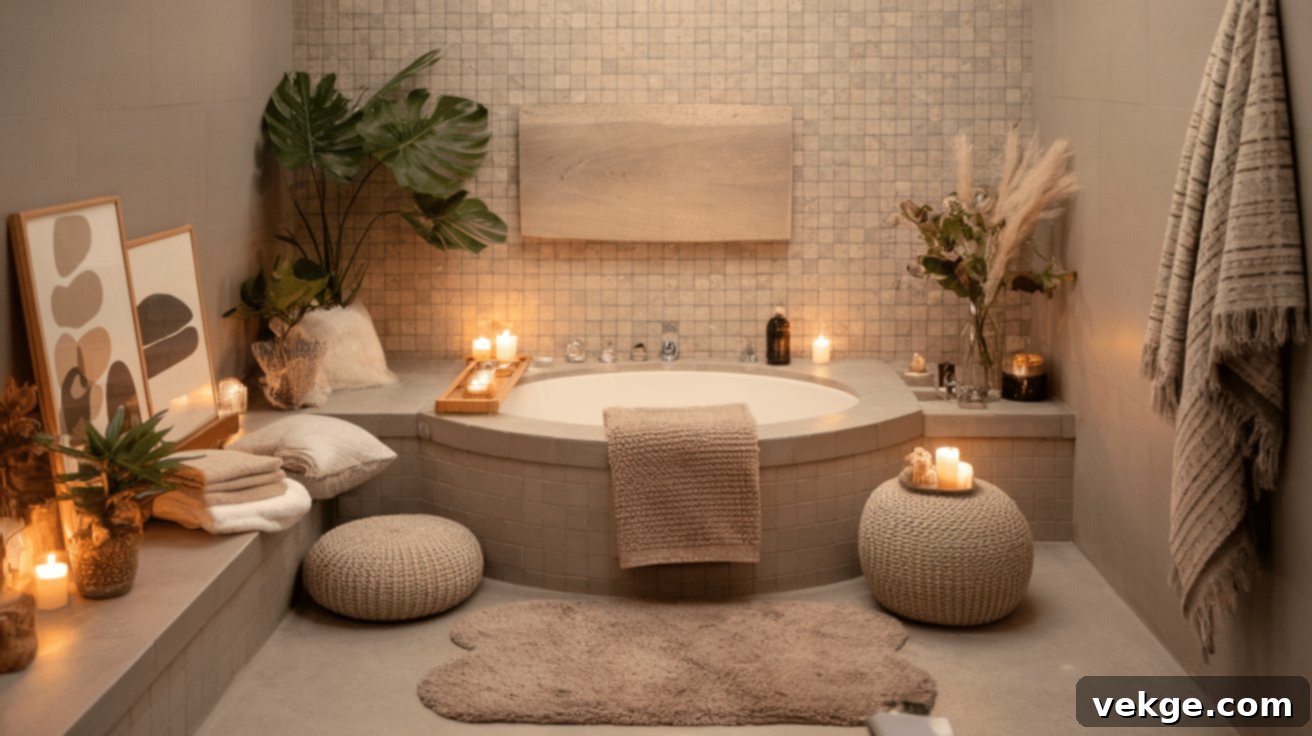
With the foundational elements of your wet room meticulously in place, it is now the opportune moment to infuse personality, warmth, and ultimate comfort through the addition of thoughtful finishing touches. These carefully selected details possess the remarkable power to transform a functional space into a truly inviting and personalized sanctuary.
Harmonious Material and Color Palette Selection
The materials you meticulously choose for your tiles, grout, and fixtures will largely dictate the prevailing mood and character of the room. Consider the timeless beauty of natural stone for a luxurious, earthy, and organic feel; large format porcelain for a sleek, ultra-contemporary, and expansive look; or even micro-cement for an industrial-chic, seamless, and uniquely textured finish. A cohesive color palette, often grounded in neutral tones for enduring elegance, can be subtly punctuated with carefully chosen accents through towels, accessories, or a captivating feature wall. Textures play an equally vital role – a smooth polished tile, for instance, dramatically contrasted with a rough-hewn wooden bench or a plush, fluffy bath mat, adds profound depth, tactile interest, and visual richness to the space.
Infusing Life with Lush Greenery
Indoor plants naturally thrive in the humid environment of a bathroom and can introduce a vibrant, organic touch to your wet room. Select varieties known for their love of moisture, such as lush ferns, elegant peace lilies, or exotic orchids. Strategically placed on a shelf, atop a vanity, or even delicately suspended, these plants not only purify the air but also bring an undeniable sense of tranquility and a refreshing connection to nature, gracefully softening the often harder lines of modern design.
Thoughtful Accessorizing and Personalization
Beyond mere functionality, intelligent accessorizing empowers you to make the space uniquely and authentically yours. Select high-quality, sumptuously absorbent towels and bath mats that flawlessly complement your chosen color scheme. Introduce luxurious bath products, aromatic scented candles, or an essential oil diffuser to cultivate a truly spa-like and inviting aroma. A carefully chosen piece of waterproof artwork or an elegantly decorative mirror can serve as a captivating focal point. Ensure all selected accessories are robustly suited to a humid environment and collectively contribute to the overarching serene and tranquil atmosphere you aspire to achieve.
Considering Professional Expertise and Budgetary Planning
While this guide offers comprehensive steps, it’s crucial to acknowledge that designing and constructing a wet room, particularly one that masterfully combines both a tub and shower, is an inherently complex project. It necessitates specialized waterproofing techniques, intricate plumbing and electrical work, and often precise, artistic tiling. Engaging experienced professionals – such as a skilled architect, a dedicated bathroom designer, or a reputable wet room installation specialist – is highly recommended. Their profound expertise will ensure that all facets of the project are handled correctly, safely, and to the absolute highest industry standards, thereby protecting your significant investment and proactively preventing any future issues.
Budgeting stands as another critical factor requiring careful consideration. Wet rooms generally entail a higher initial installation cost compared to traditional bathrooms, primarily due to the extensive and specialized waterproofing requirements and the bespoke drainage systems. It is imperative to factor in not only the cost of premium materials and high-quality fixtures but also professional fees, skilled labor costs, and a sensible contingency fund for any unforeseen issues that may arise. Obtaining multiple detailed quotes and thoroughly reviewing project specifications will significantly assist in effectively managing both expectations and overall costs.
Conclusion: Your Modern, Functional, and Luxurious Wet Room Awaits
Designing a wet room that masterfully combines the distinct luxury of a bathtub with the undeniable practicality of a shower represents an exceptional approach to transforming your bathroom into a modern, supremely functional, and undeniably stylish sanctuary. This innovative philosophy in bathroom design not only intelligently optimizes available space and significantly enhances accessibility but also cultivates a seamless, open aesthetic that radiates contemporary elegance and sophistication.
By meticulously planning and executing each critical stage – from precisely assessing your space and ensuring faultless, enduring waterproofing to selecting the perfect tub, innovative shower features, and strategic layouts – you establish the unshakeable foundation for a truly remarkable and personalized bathing experience. Always remember the paramount importance of effective splash containment achieved with sleek glass partitions, the transformative, mood-setting power of carefully layered lighting, and the absolute necessity of clever, integrated storage solutions to effortlessly maintain a pristine, clutter-free environment.
The final, exquisite touches, ranging from the discerning choice of materials and cohesive color palettes to the uplifting inclusion of lush greenery and cherished personal accents, are precisely what elevate your wet room. These elements transform it into a profound reflection of your individual style and a serene haven dedicated to relaxation and rejuvenation. While the journey of creating such a sophisticated space demands meticulous attention to detail and often benefits immensely from professional guidance, the reward is an undeniably unique, highly adaptable, and aesthetically captivating bathroom that caters to every facet of your well-being.
Embrace the creative design process, dedicate ample time to careful planning, and vividly envision the tranquil, functional space you are meticulously building. Soon, you will step into a wet room that not only looks spectacular but functions flawlessly, enriching your daily life and offering unparalleled comfort for many years to come.
Frequently Asked Questions About Wet Rooms with Tubs and Showers
Can a wet room genuinely accommodate both a bathtub and a shower effectively?
Absolutely! A wet room is perfectly suited for integrating both a bathtub and a shower within the same space. This combination is highly desirable for individuals who deeply appreciate the versatility of having both bathing options within a unified, modern, and open environment. The key to successful integration lies in thoughtful planning of the layout, ensuring efficient water drainage, and implementing appropriate splash control, which is often elegantly achieved through the strategic use of glass partitions.
How much space is realistically needed for a wet room featuring both a tub and shower?
While wet rooms are adept at optimizing space, the exact area required for a tub and shower combination can vary. Ideally, you’ll need sufficient room to comfortably fit your chosen tub size, a functional showering area, and adequate clear space for comfortable movement around both fixtures. A minimum of 7-8 square meters (approximately 75-85 sq ft) is a good starting point for a comfortable and well-appointed setup, though clever design and compact fixture choices can make it feasible in slightly smaller areas, perhaps by opting for a shower-over-bath solution.
Is waterproofing required for the entire bathroom, or just the shower area in a wet room?
For a true wet room, comprehensive waterproofing, also known as ‘tanking,’ is essential and should extend to the entire floor area and at least the lower sections of all walls. In the immediate shower zone, waterproofing should be applied to full height. This thorough approach ensures that any water splashes or incidental moisture, regardless of how far it reaches, will not cause any structural damage or lead to issues like mold. This full-scale waterproofing is the critical distinction that sets a wet room apart from a standard bathroom with an open shower.
What considerations are important when selecting a bathtub for a wet room?
When choosing a bathtub for your wet room, prioritize its size and shape relative to your available space and desired design aesthetic. Freestanding tubs offer a luxurious, sculptural focal point, best suited for more spacious rooms. Built-in or recessed tubs are generally more space-efficient and provide a seamless, integrated look, making them ideal for smaller wet rooms. Additionally, consider the tub’s material (e.g., acrylic for warmth and lighter weight, cast iron for exceptional heat retention and durability), its depth for comfortable soaking, and any integrated features like hydro-jets or a specific shower-over-bath design.
Are glass partitions essential in a wet room with a tub and shower?
While not strictly “required” in the sense that a wet room can technically function without them, glass partitions are highly recommended and considered a hallmark of modern wet room design. They are exceptionally effective at containing shower splashes, preventing water from reaching other areas like towels or the vanity, all while maintaining the open, spacious, and minimalist aesthetic that defines a wet room. They provide functional separation without creating visual obstruction, preserving the airy feel.
What are the key maintenance tips for keeping a wet room in top condition?
Maintaining a wet room is generally straightforward, largely due to its seamless design. Regular cleaning of tiles and grout is essential to prevent the buildup of soap scum and mold. Using a squeegee on glass partitions after each shower will significantly prevent water spots and limescale. Ensure your floor drain is kept clear of hair and debris to maintain efficient drainage. Crucially, robust ventilation is paramount; always run your extractor fan during and for a period after showers to rapidly reduce humidity and promote quick drying, which is vital for the longevity of your waterproofing system and overall indoor air quality.
